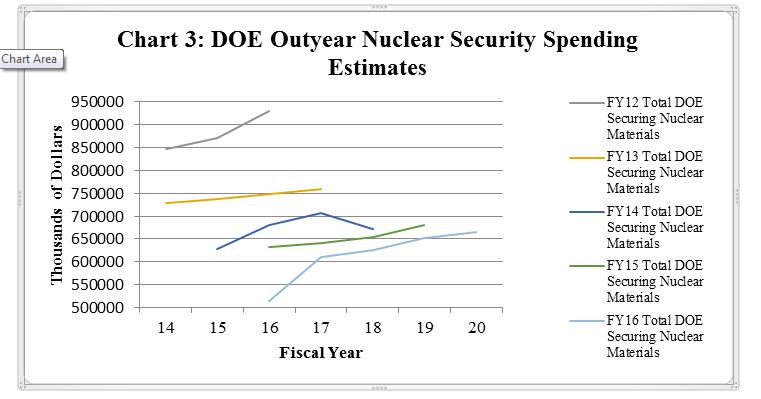Nickolas Roth
Policy Contributor, Center for Arms Control and Non-Proliferation
Originally published at Nuclear Security Matters
Key Points:
- Non-proliferation programs did not increase as much as it appears.
- The Obama administration’s five year trend of proposing unanticipated cuts to nuclear security programs continues.
- The nuclear security goals the United States set for itself over the past five years are proving far more difficult to accomplish than previously thought.
Congress has released its Omnibus appropriation bill for funding the entire government, including National Nuclear Security Administration (NNSA) nuclear non-proliferation and security programs. The following is a snapshot of the fiscal year 2016 request and Congressional appropriation process, as well as charts providing some context about what these numbers mean. This non-proliferation budget is the last that will be fully executed by the Obama administration.
Overall, funding for non-proliferation programs increased 20% compared with what Congress appropriated for fiscal year 2015 (See Chart 1). Some $234 million of this increase, however, more than a third of the total, comes from NNSA deciding to count its Nuclear Counterterrorism and Incident Response program as part of non-proliferation, rather than a real increase in non-proliferation activities.
After adjusting for this accounting change, the increase for non-proliferation programs above what was appropriated in fiscal year 2015 was closer to 5.5%, or about $90 million. The Radiological Security Program—which provides security upgrades for facilities housing radiological materials and retrieves radiological sources—was increased by 12% ($16 million). The Nuclear Material Removal program— which assists with the removal of civilian weapons-usable nuclear material around the world—was increased by 68% ($43 million). Non-proliferation research and development was increased by 7% ($26 million).
|
FY2016 Non-Proliferation Budget Request and Committee Appropriation (in thousands of dollars) |
||||||
|
2015 APPROPRIATION |
2016 BUDGET REQUEST |
HOUSE APPROPRIATIONS BILL |
SENATE APPROPRIATION BILL | OMNIBUS APPROPRIATION, 2016 | Change from FY15 | |
| Global Material Security | 424,244 | 426,751 | 422,949 | 426,751 | 426,751 |
1% |
|
International Nuclear Security |
134,875 | 130,527 | __________ | __________ | 130,527 | -3% |
| Radiological Security | 137,833 | 153,749 | __________ | __________ | 153,749 |
12% |
|
Nuclear Smuggling Detection |
151,536 | 142,475 | __________ | __________ | 142,475 | -6% |
|
Material Management and Minimization |
272,919 | 311,584 | 310,584 | 311,584 | 316,584 |
16% |
|
HEU Reactor Conversion |
119,383 | 115,000 | __________ | __________ | 115,000 | -4% |
|
Nuclear Material Removal |
68,536 | 114,000 | __________ | __________ | 115,000 |
68% |
| Material Disposition | 85,000 | 82,584 | __________ | __________ | 86,584 |
2% |
|
Non-proliferation and Arms Control |
125,859 | 126,703 | 130,203 | 126,703 | 130,203 | 3% |
|
DNN Research & Development |
393,401 | 419,333 | 419,333 | 419,333 | 419,333 |
7% |
| Non-proliferation Construction | 345,000 | 345,000 | 345,000 | 345,000 |
340,000 |
-1% |
|
Nuclear Counterterrorism and Incident Response |
__________ | 234,390 | 234,390 | _________ | 234,390 |
____ |
|
Legacy Contractor Pension |
102,909 | 94,617 | 94,617 | 94,617 | 94,617 |
-8% |
| Total Defense Nuclear Non-proliferation | 1,616,638 | 1,940,302 | 1,907,606 | 1,705,912 | 1,940,302 |
20% |
Congress allocated $514 million for NNSA programs that increase security for nuclear weapons useable materials around the world, about a million more than was requested (See Chart 2) and $57 million more than Congress appropriated for fiscal year 2015, not an insignificant amount. These increases will be important as the United States makes the case to strengthen global nuclear security at the 2016 Nuclear Security Summit in Washington, DC.

Note: From 2009 to 2015, International Nuclear Security Programs consisted of the Global Threat Reduction Initiative, International Material Protection and Cooperation, and International Nuclear Security. As a result of a reorganization of NNSA non-proliferation programs, nuclear security work is now conducted with the Material Management and Minimization and Global Material Security programs (This excludes the Nuclear Smuggling Detection and Deterrence program within Global Material Security because it is focused on smuggling, not theft prevention).
Although Congress increased non-proliferation and nuclear security funding above the Obama administration’s request, the President’s FY2016 budget proposal continues the trend of unanticipated cuts to nuclear security programs. (See Chart 3). Five years ago, NNSA predicted it would be spending $930 million on nuclear security programs in fiscal year 2016. The amount the administration requested and that Congress appropriated is $416 million, or 45% less than the anticipated amount set in 2012. It is also more than a $100 million decline in what NNSA anticipated as recently as last year.

The likely reason that nuclear security budgets have declined in recent years is because the goals the United States set for itself are proving far more difficult to accomplish than previously thought. Removal of highly enriched uranium (HEU) from Belarus or South Africa and security upgrades for nuclear facilities in Russia are delayed by political impasse. Other countries with large quantities of nuclear weapons useable materials like India, Pakistan, and China permit only the most limited amount of nuclear security cooperation with the United States.
Despite receiving its fully funding request from Congress, the future of NNSA non-proliferation programs is uncertain. With US-Russian cooperation largely suspended, the future of the plutonium disposition program in doubt, political impasses with countries such as South Africa and Belarus, and technical delays in developing high-density fuels to convert reactors, many of NNSA’s non-proliferation programs face major challenges. To sustain Congressional support next year, the administration will need a clear vision of where these programs are going and how they can get there.
